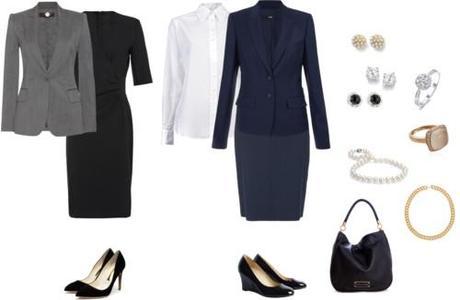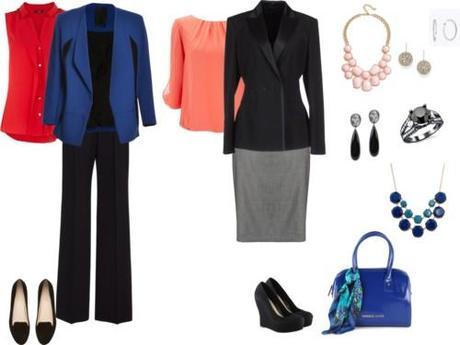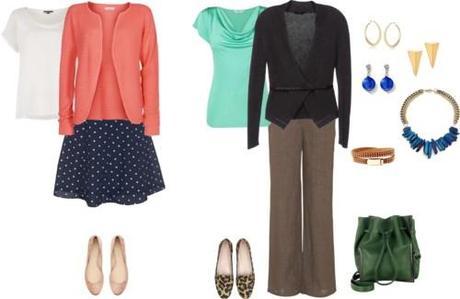As part of my job as an image consultant, I work with businesses to help their staff understand what is appropriate to wear to work, and why. Often it’s the why that people have forgotten, particularly with the casualisation of dress codes. The result is often sloppy or too relaxed and casual. So what should you think about wearing to work? It all depends on what is appropriate for your industry and work place. But think about each of these elements and what they are communicating to your colleagues and boss.
 Level 1 business dress by imogenl featuring a wool dress
Level 1 business dress by imogenl featuring a wool dress
1. Structured clothes say professional – the structure of a tailored jacket, a collard shirt and tailored trousers or skirt tell the world you mean business. We don’t wear them to clean the car, mow the lawn, or play with the kids on the floor. A suit in a darker neutral color tells the world that you’re not about to take stupid risks. It says that you are responsible, organised and successful.

If you don’t work in a formal environment you don’t have to wear a traditional suit, but do think about wearing clothing that has similar properties – add a jacket or wear a crisp cotton shirt with a pair of tailored dress trousers for a smart appearance.

Casual Friday can be a difficult one to pick what to wear. Ideally, still keep some structure in your clothing, you don’t want to look sloppy (it says you’ll do a sloppy job). Just make the fabrics less structured and more relaxed and comfortable.
2. Colour – Darker colours are more professional. High contrast light and dark together says authority. All over lighter colours will take away some of your personal power. Think about the colours you wear and what they subliminally tell everyone about you. Bright colours with dark colours say that you are dynamic and not afraid of being seen.
3. Patterns - Stripes and geometrics are a masculine pattern and are seen as more powerful and professional. Florals and spots are a feminine pattern and seen as more nurturing and less ambitious. Abstract prints are creative. Animal prints are more dramatic or non-conventional in the workplace, which is OK if you work in a creative environment, but not so appropriate in a bank!
4. Accessories – smaller more discreet metal based jewelry is seen as more classic and professional. Larger, more sparkly or coloured jewelry is says fun. Depending on your workplace, be aware of the jewelry you are wearing and how it can be interpreted. Noisy, jangly or clanky jewelry can be distracting for your co-workers.
5. Shoes – Slimmer soles, leather and finer details are more professional and are the same level of refinement as your more formal work wear. Thick soles and chunky shoes are a lower level of refinement and more appropriate for a casual environment and outfit. Women’s toes should generally be covered by their shoes if men are wearing suits to work. Plus, you don’t know who has the toe fetish in your office.
When figuring out what a piece of clothing means – think about it’s origins. Jeans were from the working man (blue collar). Sneakers from the athlete (ready to run away). Bows are from presents (unwrap me). Animal prints are from the pelts of animals (how dangerous are you?). Structured clothing were from the courts (places of power and formality). Each piece of clothing has an ideal location and use. Mixing them up can send mixed messages or make you seem unaware of what you are communicating.
We are treated how we are percieved. We are paid on not-only our performance, but the perception of how great we are. Numerous studies have shown this to be true. If you present a more professional and successful appearance, and you do a great job, doors will open for you and positions of power will be offered to you. If you present in a more casual way, you’ll find it so much harder to get through those doors as others are finding your image incongruous with what you may perceive as your abilities.
If you want that promotion it’s time to take a good hard look at what you wear to work and the messages it sends. If your clothing looks cheap, we assume you’ll do a poor quality job as you do not look like you care about quality.
Quality is about fit, fabric and construction. Good quality fabrics in designs that fit and flatter your body (yes, you will probably need an alteration or two) in a well constructed garment (no loose threads, hanging or lost buttons, hems half undone etc.) will make you look higher quality. We assume when we see someone who is well presented that they won’t accept the bottom of the pay scale as they look like they value themselves, so therefore they have higher standards and therefore should be entitled to the top end of the pay scale.
There is always a balance between expressing our personality through clothing, and toeing the dress code line. If you can learn to express your personality through your clothing but still be appropriate you will have the most success as you will appear authentic as well as professional.
How to Look Smart When You’re Not a Suit Person
How to Look Authoritative When You Have Light and Warm Colouring
Professional but Comfortable

